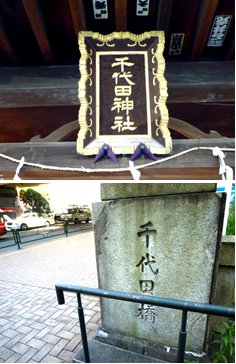In Chiyoda-ku, Edo Castle was called "Chiyoda Castle", and Kojimachi Ward and Kanda Ward were integrated and started in March 1947 (1947). "Chiyoda" means "Mita" that lasts for a very long time and millennium, so there is a place in Chuo-ku that has been attached to "Chiyoda" for a long time.
 First of all, "Chiyoda Shrine" is enshrined in Nihonbashikodenmacho. According to the origin of the notice, "In accordance with the divine spirit during the Choroku era (1457-1459), Michio Otamochi will use the spirit to the castle in Chiyoda. At the time of Tsunayoshi Tokugawa, he was transferred to Kodenma-cho with the words of Ota's former minister, Yasushiro Nagano (abbreviated below) "(upper photo).
First of all, "Chiyoda Shrine" is enshrined in Nihonbashikodenmacho. According to the origin of the notice, "In accordance with the divine spirit during the Choroku era (1457-1459), Michio Otamochi will use the spirit to the castle in Chiyoda. At the time of Tsunayoshi Tokugawa, he was transferred to Kodenma-cho with the words of Ota's former minister, Yasushiro Nagano (abbreviated below) "(upper photo).
The remains of "Chiyodabashi" remain at the site of Kabuto-cho and Nihonbashi on Eitai-dori St. It was built in the early Showa era by a reconstruction bridge after the Great Kanto Earthquake. The origin of the name of the bridge, Chiyoda, is unknown, but the west of Eitai-dori St. hits the site of Edo Castle Otemon Gate (bottom photo).
"Chiyoda Elementary School" was located in Yanokura Town on the west side of Ryogokubashi. It is the current location of Nihonbashi Junior High School. Chiyoda Elementary School opened in 1876 (1876) and was rebuilt after being destroyed by the Great Kanto Earthquake. In 1930 (1930), Emperor Showa was known for having made good fortune in the reconstruction of the earthquake.
Since the vocabulary of "Chiyoda" is a common noun, was it commonly used as a happy name in Chuo-ku? @ Akira Makibuchi

